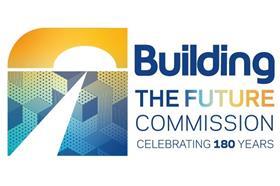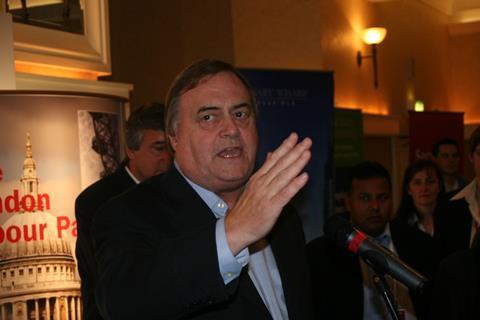For years, margins have barely shifted much beyond 3% and, to some, talk of 5% and above seems fanciful. But others believe that mandating a figure like that would turn the industry on its head. Dave Rogers reports

Can you spot the difference?
“[The firm] argues that margins of 2% to 2.5% in construction undermine arguments that the private sector is ripping off the taxpayer.” That was a line from a newspaper article on whether contractors were, well, fleecing the state.
“You can’t run a multibillion-pound business on a 2% margin. That’s not normal business practice.”
In fact, there is no difference to spot. The firm in question arguing that margins of 2% were, in fact, not much was Mowlem and its chief executive John Gains was speaking in 2001, sticking up for contractors as arguments raged about whether the Private Finance Initiative was a get-rich-quick scheme.
The person expressing incredulity about how firms manage to operate on margins of 2% was Mark Robinson, the chief executive of Scape. He was speaking last month. And the point is obvious: in those 22 intervening years, margins have barely shifted.
Here is another observation. Mowlem no longer exists and neither does Carillion, the firm that bought it. But eye-wateringly low margins continue to dog the industry.
In its last set of accounts Laing O’Rourke, the country’s biggest private contractor, had a turnover of £3.1bn. But, hobbled by losses at its Australian business, it made a pre-tax profit of just £2.7m. That is not even 0.1%.

The latest results season for quoted firms has come and gone this spring. Picking two of those firms, Galliford Try, which revealed improved half-year results, said it remained on course to hit its 3% operating margin target by 2026. Meanwhile Costain is looking at 3.5% next year, 4.5% the year after and, from 2026, the holy grail of 5%.
Without making Gains’ comments from 2001 a year-zero benchmark, Galliford Try’s 2026 target is really not much different from 20-odd years ago.
Bill Hocking, its chief executive, thinks it is better to aim for something attainable rather than shoot for the stars and miss. He says his firm can improve margins from a current 2.3% by efficiencies in design, more use of digital, not doing things twice and improving the quality of its order book.
He says the firm recently walked away from a new-build commercial job in London. It was in the sole negotiating position for the £70m scheme. “The client just became totally unreasonable, wanted us to take risks that were just unmanageable.”
As for Costain and its boss Alex Vaughan, the 5% number is something to target in another three years’ time. The firm is increasing its consultancy work – which traditionally pays better margins.
“We expect to increase margins as we enact further operational improvements in the business during 2023 and beyond, and as we continue to grow the scale of our consultancy services,” he says.
Costain’s operating margin last year was 2.5% so it is understandable that there are those who think 5% is out of reach.
Robinson, certainly, is one of those. “I don’t think [firms] will ever get to 5% the way things are right now,” is his gloomy assessment. “Some might go close one year, but I don’t think it will be consistent.”
The case for mandating margins
All this matters because the industry knows it has a productivity problem and the link between better margins and better productivity is binding. Better productivity usually means better margins and better margins means more reinvestment into skills and training, new ways of working such as increased use of digital, better equipment running on site and so on. It all goes hand in hand.
Ever since the late Sir Michael Latham, a former Conservative MP, published his Constructing the Team report in summer 1994, the industry has been hit with recommendations on how it can be better. Latham‚Äôs report was described by Rupert Jackson, at one time the judge in charge of the Technology and Construction Court, as the ‚Äúwhirlwind which hit the construction industry‚Äù. The ∫⁄∂¥…Á«¯ the Future Commission might not promise to be a whirlwind but it is hoping to find solutions to some of the industry‚Äôs ongoing structural issues. And on margins, does repeated failure to get them out of the doldrums where they have languished for years require something radical such as state intervention?
Low barriers to entry, too many one-off clients looking for lowest cost and firms willing to do a job cheaper than others have all helped to keep a lid on contractor margins.
For Robinson, the issue of margins – and improving them – is one of his three most pressing industry issues, along with mandating a single form of contract for all public sector work and ensuring clients give due weighting to sustainability credentials during the tendering process. “Construction is a dirty industry and we have to do something about that,” he says.
What Robinson says is important because the organisation he heads up operates with a buying power of £18bn and is actively performance managing over 1,800 live projects.

He has been arguing for some years that fixing profit margins at an agreed figure – his is 5% – will revolutionise how clients commission work and how the industry operates.
Clients would have transparency and not have to wonder whether budgets were being inflated by firms to squeeze more money out of jobs. And contractors could be left to get on and build what they have been asked to without steeling themselves for post-project disputes.
He says they could then make reinvestment plans, recruit better quality people to manage their projects more effectively and invest in new technology and equipment.
“Arguing about cost does affect productivity and, if you fix it, all that goes away. Let’s fix the profit for the delivery partners so they can worry about delivering the project and focus on the project.”
He thinks the 5% figure is a good number. “[Contractors] will reinvest it in their business. They’re not going to use it to buy Ferraris or villas in the Caribbean.”
There will, he adds, be no need to send in the auditors to check whether firms are investing in new technology, people and so on. “The tier ones I speak to are crying out to invest. If margins are more sustainable, they can invest more.”
As anyone who has been in the industry long enough knows, several initiatives to fix its structural issues have come and gone. Their success has been difficult to measure but the reports by Latham, and later ones by the industrialist Sir John Egan and the former EC Harris partner – later the founder of Cast – Mark Farmer have all said that something needs to be done.
For Robinson, the difference is that all these reports were recommendations – none was compulsory. It might have made sense to follow their suggestions but it was not enshrined in law.
Where the government had made a difference and stepped in, it has worked he says. “Health and safety in this industry changed because of regulation and legislation,” he adds remembering the safety summit called by then deputy prime minister John Prescott in March 2001 after a string of high-profile accidents in the prior two years which saw death rates hit new highs.
More than 700 people from all areas of construction sat down at the QEII Centre in London to try and thrash out a strategy to make sites safer. Prescott gave them six months to start showing an improvement.
Robinson thinks the government could step in again, this time on margins. “All this would take is for the government to change its policy on procurement and mandate it across all its contracts. It’s the principle that counts.”
Mace chief executive Mark Reynolds, who is also the chair of the Construction Leadership Council, the industry group which aims to improve the business of construction, admits: “If government took leadership [on this] it would be extremely helpful.
“It would create a level playing field, and a sensible profit margin means you are not arguing about semantics. There’s always a level of ambiguity in contracts, so therefore a level playing field would really help.”
Efforts to improve productivity
In the middle of April, the latest initiative to try and make things better, among them improving productivity, will launch. The Construction Innovation Hub’s (CIH) Value Toolkit follows a development programme that has featured contributions from more than 200 industry partners.

The toolkit, which is designed to change the way the industry thinks about and measures value, is one of the key initiatives of the CIH, which was set up with £72m five years ago.
Ellie Jenkins, who spent a decade at Bam Construct and now works for consultant Akerlof, has helped work on the report and says: “In essence, the Value Toolkit is a methodology designed to empower clients and policymakers to work with their supply chains to make informed, value-based decisions that drive better social, economic, and environmental outcomes.
“If we can encourage clients to put value first, that should improve outcomes for contractors.
“It isn’t a tool that has been designed to increase contractor margin. However, moving from a cost to value-led culture for the sector is a step to a more sustainable sector all round.”
In a forward for an overview of the toolkit, Rory Kennedy, the director of capital at the Department for Education, writes: “The Value Toolkit is a suite of tools, processes, and guidance that will empower clients and policy makers to make smarter, more informed, decisions.
“Government and private sector clients achieve greater value, certainty, and performance from their investment. Industry can innovate and invest to become more productive, sustainable and profitable.”
It all sounds so simple, but Robinson, who started out on the tools as a joiner for Sheffield city council in 1989, will not be the only one to have reservations. “It’s a start but, if it’s voluntary, I’m not sure how much of it will work.”
He thinks the industry is biting off more than it can chew, running around and trying to fix everything at once. “It’s trying to do 20 or 30 things,” he says.
“We should keep it simple. Do two or three things, sort them out, then do another three – and so on.”
A need for better processes and delivery
Mace’s Reynolds says the industry has to carry out self-help too, it cannot just rely on well-meaning reports and initiatives.
“We can’t just take,” he adds, “we have to improve productivity and efficiency through MMC, digital, better business models. We have to invest in better systems, support the supply chain and make sure we’re legal and compliant, otherwise we can’t trade.”
But he says clients and consultants have to change attitudes too. “There has to be a shift from them about what is a reasonable return.”
For Simon Rawlinson, head of strategic research and insight at Arcadis, improving productivity and increasing margins go hand in hand. “Solving the productivity issue has to be a key part of construction’s solution,” he says. “However, detailed planning, comprehensive controls, focused collaboration and useable data do not naturally align with how construction prefers to deliver its work.
“Too often project teams prepare for failure by failing to prepare, and in order to improve performance, the industry does need to improve planning and delivery of work to make better use of its existing resources.”
Mark Robinson’s plan for margins – and to fix construction
- Agree in principle the figure needs to go up and then come to a number. He thinks 5% is a fair amount. “Agree a standard principle and then agree what’s a reasonable number.”
- Trial it on certain contracts or in certain parts of the country.
- “I like it simple and straightforward,” Robinson says. “This one change could revolutionise how clients commission work and how the industry operates.”
- Robinson also says as well as fixing margins, mandating a single form of contract for all public sector projects would mean the number of types of contract used across the public sector would be minimised and with it the number of costly and time-consuming disputes
- And he says sustainability should be given the same weight as price and quality in every tender evaluation. Doing so will force clients to take it seriously by reducing carbon across all projects. “Construction is a dirty industry and we have to do something about that.”
Older readers may well remember a company called Birse, which split its time between building roads and new stadia for football clubs, such as Leicester City’s Walkers stadium and the Reebok for Bolton Wanderers as well as expanding Manchester United’s Old Trafford ground.
In 1997 Birse made a public apology for being aggressive in the early 1990s. Chairman Peter Birse promised a new, cuddly approach to contracting and management consultants were called in to reform attitudes.
Profits failed to improve significantly and Birse himself resigned in 1999 protesting that contracting was a “bloody waste of time”. The firm was later bought by Balfour Beatty for £32m in 2006.
Birse was listed and, in one set of half-year results – those for the six months to October 2000 – it blamed legal battles for racking up exceptional items of £24m.
It might be more than 20 years ago, but for Robinson too much of this still goes on. “For some people, they quite like a battle around the cost. They like a bunfight. That culture has to change.”

An end to ‘them and us’
He also has sharp words for those in the public sector who think protecting the taxpayer means squeezing firms on cost. “I honestly believe some people enjoy minimising the profit for delivery partners,” he says.
“That’s what they are, our partners – and we need to treat them with respect. They think they’re trying to get best value for the taxpayer and they think lowest cost is best value. They don’t see the long-term picture. Government could help with this.”
He says there seems to be a them-and-us attitude: the public sector protecting taxpayers as best it can from greedy, private firms.
Mowlem’s John Gains, all those years ago, was being forced to defend PFI. Part of the interview, which appeared in The Guardian, ran thus: “His support for this controversial policy [PFI] is hardly surprising. His company is making millions of pounds in profits from public sector contracts.”
Really? In 2003, Mowlem’s construction business made a 2% margin on a turnover of £1.5bn. Moreover, what are private firms supposed to do on public sector jobs? Rack up losses instead?
“In the public sector,” says Scape’s Robinson, “there can be some resistance about private firms making super profits. There are some who think private firms shouldn’t be making any money out of the public sector.”
He thinks his 5% margin idea could be mandated and then trialled in certain areas or on particular projects. “It will take a couple of years to see what the results are but, unless you try, you’re always going to stay the same.
“Firms would be able to invest more in technology, which would make a massive difference that clients would get a benefit from. At the moment, the firms are not able to do that because of the razor-thin margins.
“You would get a slicker process on site. It would be a win-win for clients and contractors.”
The ∫⁄∂¥…Á«¯ the Future Commission

The ∫⁄∂¥…Á«¯ the Future Commission is a year-long project, launched to mark ∫⁄∂¥…Á«¯‚Äôs 180th anniversary, to assess potential solutions and radical new ways of thinking to improve the built environment.
The major project’s work will be guided by a panel of 19 major figures who have signed up to help guide the commission’s work culminatuing culminate in a report published at the end of the year.
The commissioner include figures from the world of contracting, housing development, architecture, policy-making, skills, design, place-making, infrastructure, consultancy and legal.
The commissioners include Lord Kerslake, former head of the civil service, Katy Dowding, executive vice president at Skanska, Richard Steer, chair of Gleeds, Lara Oyedele, president of the Chartered Institute of Housing, Mark Wild, former boss of Crossrail and chief executive of SGN and Simon Tolson, senior partner at Fenwick Elliott. See the full list here.
The project is looking at proposals for change in eight areas:
- Education and skills
- Housing and planning
- Energy and net zero
- Infrastructure
- ∫⁄∂¥…Á«¯ safety
- Project delivery and digital
- Workplace culture and leadership
- Creating communities
>> Editor‚Äôs view: And now for something completely positive - our ∫⁄∂¥…Á«¯ the Future Commission
>> Click here for more about the project and the commissioners
∫⁄∂¥…Á«¯ the Future is also undertaking a countrywide tour of roundtable discussions with experts around the regions as part of a consultation programme in partnership with the regional arms of industry body Constructing Excellence. There is also a young person‚Äôs advisory panel.
We are inviting readers to submit ideas for how to improve the built environment which will form part of our Ideas Hub coming soon.



























No comments yet